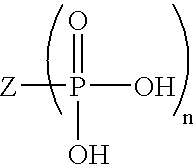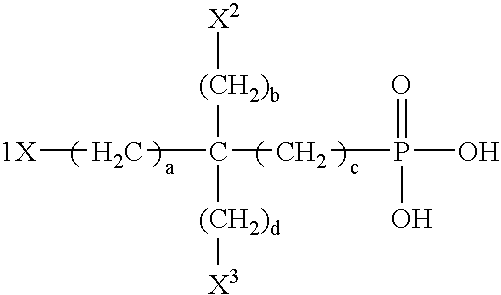Ophthalmic composition containing a polyol-acid copolymer
a technology of polyolacid copolymer and composition, which is applied in the direction of other chemical processes, paints with biocides, coatings, etc., can solve the problems of degrading lens performan
- Summary
- Abstract
- Description
- Claims
- Application Information
AI Technical Summary
Benefits of technology
Problems solved by technology
Method used
Image
Examples
example 1
Preparation of Copolymer of Glyceryl Methacrylate and Acrylic Acid
[0070]A 500-ml round-bottom flask was connected with a nitrogen inlet and a condenser. The flask was immersed in an oil bath and charged with 240 mL deionized water. The following reagents were added to the flask through a syringe −6.417g (40.06 mmol) glyceryl methacrylate, 0.722g (10.02 mmol) acrylic acid, and 0.086g (0.524 mmol) AIBN polymerization initiator. The contents of the flask were bubbled with nitrogen for 20 minutes. The nitrogen flow was reduced to a lower rate, and the flask was heated to and maintained at 70° C. under nitrogen purge for two days. The mixture was then cooled to room temperature and saved as 3% solution.
[0071]The copolymer of Example 1 was formulated at 0.1% with 3 ppm alexidine in 50 mM sodium phosphate buffer at pH 7.2. The disinfection efficacy of the formulation was tested following the Stand-alone Biocidal procedure outlined in ISO 14729, International Standardized Document for Ophth...
example 2
Preparation of Copolymer of N-vinylpyrrolidone and Methacrylic Acid
[0072]Distilled N-vinylpyrrolidone (NVP, 5.38 g, 48 mmoles) and methacrylic acid, 0.384 g, 4.8 mmoles), Vazo-64 (AIBN, 0.05 g, 0.3 mmoles) and distilled THF (60 ml) are added to a one liter reaction flask fitted with a magnetic stirrer, condenser, thermal controller, and a nitrogen inlet. Nitrogen is bubbled through the solution for 15 min to remove any dissolved oxygen. The reaction flask is heated to 60° C. under nitrogen for 16 hrs. The resulting reaction mixture is slowly added to 3L of ethyl ether with good mechanical stirring. The copolymer precipitates and is collected by vacuum filtration. The collected solid is placed in a vacuum oven at 30° C. overnight to removeany remaining ether. The copolymer is placed in a desiccator for storage until use.
TABLE 1timeLog ReductionPolymer(hr)SaPaSmCaFsnone12.1>5.02.70.12.543.5>5.0>4.9 1.04.3Carbomer 934P10.22.1TNTC00.44TNTC3.41.10.1TNTCCarbomer 94110.21.9TNTC00.54TNTC3....
example 3
Preparation of PHMB-CG
[0073]PHMB (Cosmocil® 100, 6.0 g, 3.3 mmol) (Cosmocil® 100 is a solid form of PHMB), hexamethylene bis(cyanoguanido) (HMBDA) (1.8 g, 7.2 mmol) and concentrated hydrochloric acid (720 μL) are added to a reaction flask and heated to 100° C. until most of the liquid dissipates from the flask. The temperature of the reaction mixture is then heated to 155° C. for one to four hours, which can vary the percent of cyanoguanidino terminal groups of the PHMB-CG*. The reaction is allowed to cool overnight to room temperature over a flow of nitrogen. The resulting solids are dissolved in 60 mL of distilled water and solution purified by dialysis (100 MWCO tubing) overnight. The purified product is then freeze dried overnight.
PUM
| Property | Measurement | Unit |
|---|---|---|
| mol % | aaaaa | aaaaa |
| molecular weight | aaaaa | aaaaa |
| pH | aaaaa | aaaaa |
Abstract
Description
Claims
Application Information
 Login to View More
Login to View More - R&D
- Intellectual Property
- Life Sciences
- Materials
- Tech Scout
- Unparalleled Data Quality
- Higher Quality Content
- 60% Fewer Hallucinations
Browse by: Latest US Patents, China's latest patents, Technical Efficacy Thesaurus, Application Domain, Technology Topic, Popular Technical Reports.
© 2025 PatSnap. All rights reserved.Legal|Privacy policy|Modern Slavery Act Transparency Statement|Sitemap|About US| Contact US: help@patsnap.com


